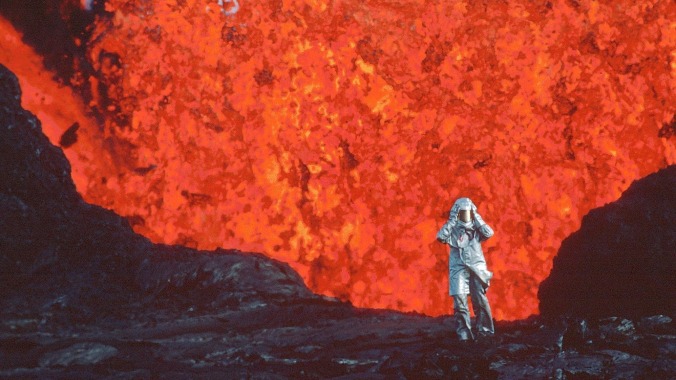Fire Of Love is packing heat as well as heart
Sara Dosa's gorgeous and affecting documentary filters the beauty and danger of the natural world through two volcanologists' marriage
Film Reviews Fire of Love
The most enchanting American nonfiction offering at the 2022 Sundance Film Festival, director Sara Dosa’s Fire Of Love is a one-of-a-kind story of both science and romance, a movie which captures the overlapping unpredictability and ineffable beauty of both volcanoes and human bonds, and the unknown length of fuse which each ultimately possess. Positively swollen with vulnerability in addition to an infectious curiosity about the world, it’s the type of film which leaves the trajectory of your day inarguably changed—colors a little brighter, feelings a bit rawer, reflections a bit heavier.
More than 15 years on from the groundbreaking, Peabody- and Emmy Award-winning Planet Earth series, nature documentaries are at this point their own lucrative sub-genre. The least demanding of this lot do little other than forcibly drag a viewer’s attention away from concrete castles and human endeavors, and even absent any animals (cuddly or otherwise), it’s fairly easy to envision Fire Of Love being packaged, in simple and perfunctory fashion, as just another exploration of the natural world’s inherent wonders.
Instead the movie, narrated by Miranda July and constructed around hours of jaw-dropping, never-before-seen 16mm footage, undertakes a more substantive interrogation of nature and humankind’s relationship with it. At the film’s center are Maurice and Katia Krafft, pioneering married French volcanologists who studied, photographed and recorded lava flows all across the globe throughout the 1970s and ’80s.
After some biographical set-up and a touching presentation of their courtship, Fire Of Love settles into a steady occupational groove. The science presented here is interesting and informative without ever being overwhelming; broadly speaking, volcanic classifications are basically distilled down to eruptions of red lava (which are basaltic, land-creating and thus friendly) and grey plumes (which are more deadly), which helps give an audience some context for the footage it’s watching.
As the pair become more successful within their field, the Kraffts funnel most of their money back into traveling the world, exhaustively chronicling gaseous emissions and other hard data to devise an effective warning system to flag pending eruptions and evacuate endangered populations. Maurice, who is shown in his own way to be the ultimate independent filmmaker, also becomes fixated on the idea of sailing and floating in sulphuric lakes, and even kayaking down lava flows, which sounds like the type of thing Jackass filmmaker Jeff Tremaine might have bookmarked on his computer.
If this intersection of material and subjects all sounds like a magnet for Werner Herzog, who has long been fascinated with colorful characters and the extremes of Mother Earth, that’s understandable. Herzog has actually trained his eye on volcanoes a number of times previously, in everything from the short film La Soufrière to Encounters At The End Of The World, Into The Inferno (which actually featured a segment on the Kraffts, including footage they shot) and even the narrative feature Salt And Fire.
The most apt point of comparison from Herzog’s filmography to Fire Of Love, though, may actually be Grizzly Man, which is similarly interested in examining the brutal intractability of nature, but using that as a way to better understand human feeling, choice, and action—especially those that seem radical or dangerous to most people.
To be fair, Dosa doesn’t share Herzog’s decidedly grim worldview. And her film lacks, in the form of Grizzly Man’s Timothy Treadwell, a figure whose therapeutic soliloquies, imagined conversations, and self-pitying and paranoia-tinged rants clearly put him at odds with modern society. Fire Of Love has no anger, nor agitation. It is the flip-side opposite, a movie of embraced serenity. Still, the Kraffts (especially Maurice) were in some ways similarly obstinate figures. Their tolerance of increased risks was simply a reflection of the life value they felt they accrued from the beauty of witnessing volcanoes up close.
There are many other similarities between the two movies, too—from their foundational reliance on self-captured footage to their overall ambitiousness. As with Herzog, Dosa shows a deft touch in tackling esoteric ideas, translating philosophical weightiness into not just relatable but highly poignant reflections on shared universal truths, no matter what someone’s broader relationship may be with nature.
Acquired for release by National Geographic Documentary Films and Neon following an intense post-Sundance bidding war, Fire Of Love deservedly picked up the Jonathan Oppenheim Editing Award at the festival. Much of the archival footage itself is incredible, and the film would exude a woozy, mesmeric hold on a purely visual level even if it merely presented as a talking-head guided tour through the very unusual lives of its interesting subjects. As a self-taught videographer, that’s how keen of an eye Maurice Krafft had, but under Dosa’s guidance, editors Erin Casper and Jocelyne Chaput shape this footage into something special.
The manner in which the film frames the trajectory of its subjects’ work is masterful, and the pair’s intuitive understanding of the Kraffts’ two different personalities is also evident in editorial choices within some of the movie’s on-location volcano footage, which deepens the depicted relationship between Maurice and Katia. Abetting this lovingly curated look at soul-matched affinities is a wonderful score from composer (and Air member) Nicolas Godin, which further buoys Dosa’s inspired choice to bring on July for ruminative narration.
Each of these technical pieces, by itself, is superb. But the sum total result is a gorgeous cinematic collage, and something beautifully, unexpectedly affecting—a movie that eschews any traditional power-grabs at sentimentality, and instead takes hold of one’s heart from a surprising angle.